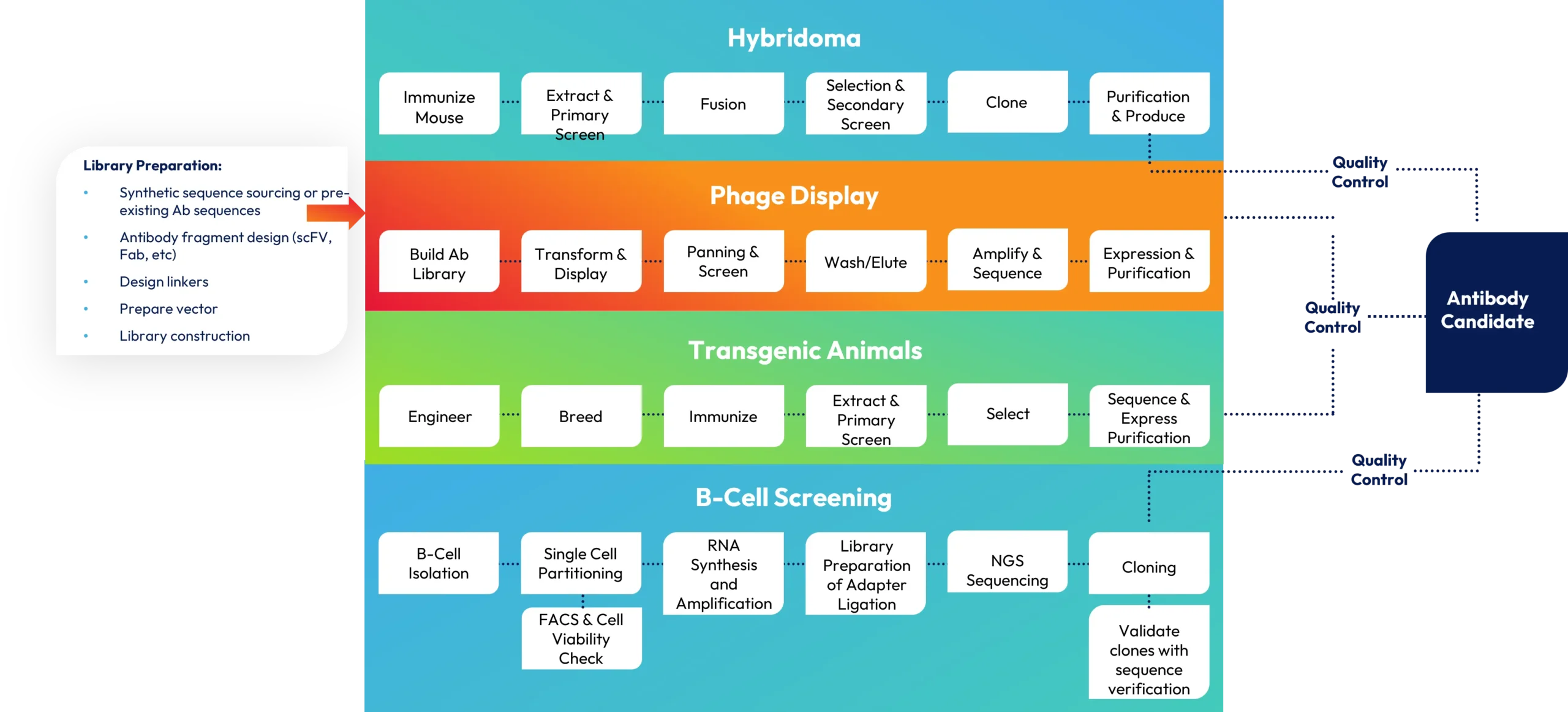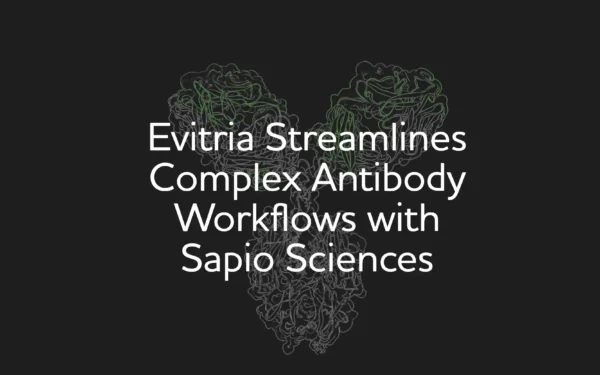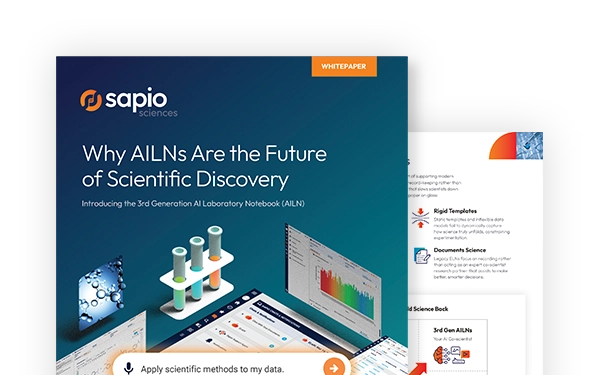The pace of antibody discovery continues to accelerate, and with it comes increasing complexity in managing experimental workflows, large datasets, and compliance requirements. High-throughput screening, rigorous material characterization, and cross-team collaboration all require seamless data integration. Without the right laboratory informatics solution, researchers face inefficiencies that slow discovery and complicate decision making.
An integrated laboratory informatics platform is no longer a luxury—it’s a necessity. By connecting disparate data sources, automating discovery workflows, and ensuring data integrity, the right platform can dramatically improve productivity and accelerate the path to the next breakthrough antibody therapeutic.
The challenges of antibody discovery informatics
Antibody discovery workflows generate vast amounts of data, often collected across multiple instruments and analyzed by diverse teams, including molecular biologists, protein scientists, and biochemists. Despite advancements in digital lab tools, many research teams still rely on siloed systems that require manual data transfer between Electronic Lab Notebooks (ELNs), Laboratory Information Management Systems (LIMS), and Scientific Data Management Systems (SDMS). This disjointed approach creates inefficiencies that hinder progress.
A fragmented informatics landscape leads to:
- Poor traceability and data inconsistencies
- Bottlenecks in high-throughput screening workflows
- Limited collaboration across research teams
- Challenges in maintaining compliance with regulatory standards
For antibody discovery teams to work efficiently, they need a centralized ELN solution that integrates data seamlessly across workflows, enabling real-time collaboration and faster decision making.
The power of an integrated informatics platform
A comprehensive informatics solution streamlines antibody discovery by eliminating data silos and enhancing workflow connectivity. Scientists can track, analyze, and share experimental data without disruption, leading to more efficient research and higher-quality outcomes.
Seamless data integration across instruments
High-throughput antibody discovery requires data from multiple sources, including flow cytometry, biopanning, ELISA, PCR, and chromatography-based purification. An ELN that integrates with these instruments enables researchers to collect, format, and centralize experimental data automatically.
For example, tracking antibody-producing B cells extracted from different sources—whether from peripheral blood, spleen, or lymph nodes—requires immediate data access to inform downstream scientific decisions. The same applies to engineering desired antibody properties via in silico (computational) protein design methods.
With an integrated platform, scientists no longer have to search through disparate files or manually reconcile data points; everything is centralized, searchable, and readily available for the next step in the workflow.
Centralized data for high-throughput screening
Antibody discovery workflows often span weeks or months, generating extensive datasets that must be consistently managed and analyzed. From molecular weights to kinetic binding data, researchers need a reliable ELN to ensure standardization and traceability across experiments.
By centralizing data, teams can eliminate inconsistencies and ensure that high quality control (QC) standards are maintained throughout the discovery process. This structured approach enhances scientists’ execution to optimize antibody candidates rather than troubleshoot data discrepancies.
Ensuring compliance and streamlining regulatory submissions
Regulatory approval for antibody therapeutics involves extensive documentation of research and development activities. An ELN tailored for compliance simplifies the process by automatically capturing and organizing preclinical data, maintaining detailed experiment protocols, and ensuring proper documentation of characterization and validation studies.
For instance, when preparing an Investigational New Drug (IND) application, scientists can rely on an integrated informatics platform to streamline data compilation, reducing the burden of manual reporting and ensuring submission-ready documentation. Additional examples of how an ELN can streamline documentation are described in the table below:
| Submission | Delivery |
| Investigational New Drug Application (IND) | ELN serves as the centralized repository for capturing and organizing preclinical data, maintaining experiment protocols, and documenting analyses. |
| New Drug Application (NDA) | ELN facilitates comprehensive documentation of characterization development and validation control in research and discovery, and analytical methods. |
| Risk Evaluation and Mitigation Strategy (REMS) | ELN supports structured collection of safety data, adverse event monitoring, and pharmacovigilance activities with workflows that ensure consistent documentation for risk assessment. |
Optimizing antibody discovery with a unified platform
A well-designed informatics solution does more than just store data—it enhances scientific workflows, making discovery more efficient from start to finish. By unifying ELN, LIMS, and SDMS functionalities, researchers can seamlessly manage samples, track experimental progress, and perform advanced analyses without unnecessary friction.
Accelerating collaboration and decision-making
Antibody discovery is a multidisciplinary effort that involves molecular biologists, medicinal chemists, structural biologists, and protein purification experts. A unified informatics platform enables real-time data access and collaboration across these teams, ensuring insights from one experiment inform the next.
With streamlined data sharing, teams can prioritize experiments more effectively, reducing bottlenecks and improving overall workflow integrity.
Enhancing data searchability and contextualization
A robust ELN makes scientific data easily searchable and contextualized. By integrating datasets from multiple experiments, researchers can uncover relationships between variables, optimize lead selection, and improve the overall efficiency of antibody screening and characterization.
For example, combining ELISA results with flow cytometry data provides a clearer picture of antigen specificity, antibody affinity, and other crucial binding kinetics. An advanced informatics platform enables scientists to connect these data points seamlessly, eliminating the need for manual cross-referencing.
Streamlining molecular biology workflows
Antibody discovery is inherently complex, requiring careful coordination across multiple experimental stages. The right ELN simplifies molecular biology workflows by integrating data capture, immunization tracking, sample collection, and high-throughput screening.
With structured, searchable data repositories, scientists can confidently track antigen specificity, monitor sample viability over time, and optimize gene library designs for cloning and sequence assembly. This level of visibility ensures consistency and reproducibility in antibody development.

A smarter approach to antibody discovery
Every antibody discovery program follows its own unique trajectory, but all require a reliable, scalable informatics solution. Whether teams are running hybridoma screens, phage display selections, or direct B-cell isolations, the ability to seamlessly track, analyze, and share data is essential for success.
A modern informatics platform adapts to these diverse workflows, offering:
- Customizable templates for different antibody discovery approaches
- Seamless integration with existing lab infrastructure
- End-to-end traceability for regulatory compliance
- End-to-end visualization of methodology approaches and data transfer
With real-time data visibility, researchers can refine discovery strategies, improve efficiency, and accelerate the development of novel antibody therapeutics.
The bottom line: Unifying informatics for faster, more efficient antibody discovery
An integrated ELN, LIMS, and SDMS platform eliminates the inefficiencies of fragmented data management, enabling scientists to:
- Improve workflow connectivity and reduce manual data handling
- Maintain compliance with regulatory standards effortlessly
- Enhance collaboration across multidisciplinary teams
By implementing a unified informatics solution, antibody discovery teams can work smarter, move faster, and ultimately bring high-quality therapeutics to market more efficiently.
Ready to transform your antibody discovery workflow?
Sapio’s fully integrated informatics platform is the key to unlocking streamlined, data-driven research that drives better outcomes. Discover how evitria improved their workflow management and reporting to increase efficiency and precision.





